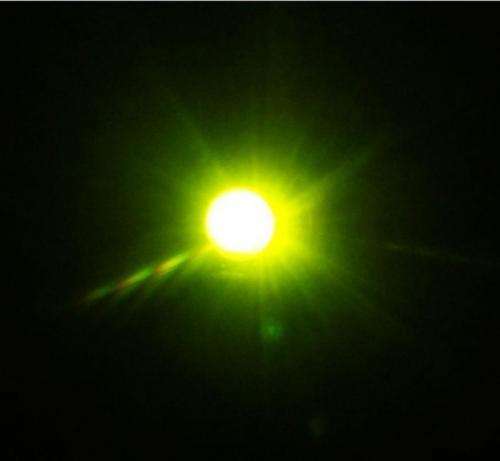August 12, 2014 report
Researchers achieve chemical identification of powders from a distance using random Raman lasing

(Phys.org) —A team of researchers from several institutions in Texas has found a way to identify compounds from a distance using random Raman lasing. In their paper published in Proceedings of the National Academy of Sciences, the team reports that they were able to identify several powders using Stimulated Raman Scattering (SRS) from a distance of 400 meters.
Being able to determine the components of a material from a distance could offer some serious benefits to applications such as explosives detection, exoplanet exploration and even agriculture. Unfortunately, we still don't have the tools necessary to conduct such tests, which is why researchers are hard at work trying to figure out a way to make it happen. In this new effort, it appears the research team has made a major breakthrough.
Scientists have known for some time that shining laser light onto (or through) a material can be used to help identify a substance—some of the photons collide with molecules in the compound causing the photons to change energy levels (color) which can be read by a spectrometer. This is known as Raman scattering. The problem is that it occurs with so few of the photons—only one in 1010 photons undergo spontaneous Raman scattering, making it exceeding difficult to read. But recent work by others has found that there is something called random Raman lasing that can also occur when very intense laser light hits a material—the photons that scatter can stimulate other photons in a similar manner producing a brightly scattered signal strong enough to be detected.
To find out if SRS could be used to identify different powders, the researchers set a powerful laser on a bench in their lab along with multiple mirrors for bouncing the laser light back and forth 13 times (to simulate traveling 400 meters in a straight line) before allowing it to strike the powder under study. The team reports that doing so allowed for reliably identifying several powders and in the process showed that at least some compounds can indeed be identified from a distance. The researchers note that if degradation of the laser beam due to traveling back and forth were discounted, the effective distance covered would be approximately one kilometer.
While the results of the team are impressive, it likely won't mean laser detectors being deployed any time soon—tests must be done in real world experiments first and then there is the problem of figuring out how to deploy such powerful lasers in the field.
More information: Single-shot stand-off chemical identification of powders using random Raman lasing, Brett H. Hokr, PNAS, DOI: 10.1073/pnas.1412535111
Abstract
The task of identifying explosives, hazardous chemicals, and biological materials from a safe distance is the subject we consider. Much of the prior work on stand-off spectroscopy using light has been devoted to generating a backward-propagating beam of light that can be used drive further spectroscopic processes. The discovery of random lasing and, more recently, random Raman lasing provide a mechanism for remotely generating copious amounts of chemically specific Raman scattered light. The bright nature of random Raman lasing renders directionality unnecessary, allowing for the detection and identification of chemicals from large distances in real time. In this article, the single-shot remote identification of chemicals at kilometer-scale distances is experimentally demonstrated using random Raman lasing.
Journal information: Proceedings of the National Academy of Sciences
© 2014 Phys.org




















